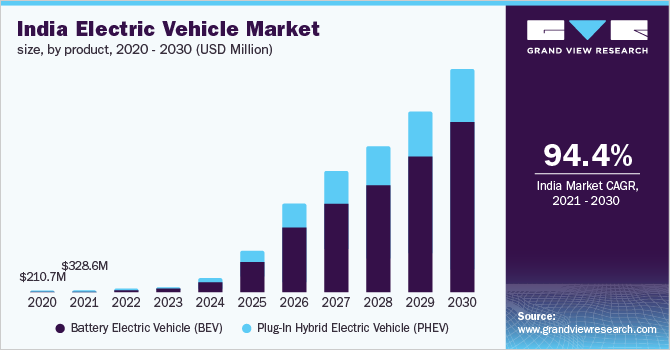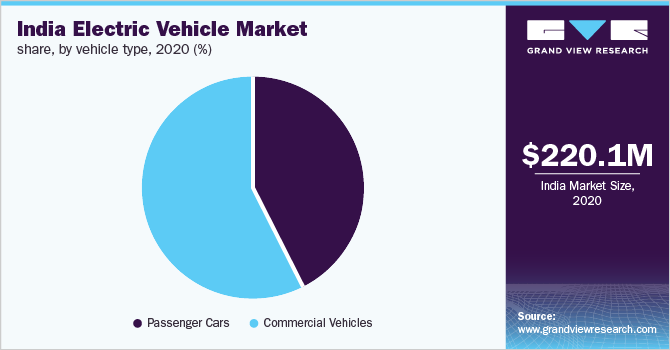- Home
- »
- Automotive & Transportation
- »
-
India Electric Vehicle Market Size And Share Report, 2030GVR Report cover
![India Electric Vehicle Market Size, Share & Trends Report]()
India Electric Vehicle Market Size, Share & Trends Analysis Report By Product (BEV, PHEV), By Vehicle Type (Passenger Cars, Commercial Vehicles), And Segment Forecasts, 2021 - 2030
- Report ID: GVR-4-68039-640-4
- Number of Pages: 110
- Format: Electronic (PDF)
- Historical Range: 2016 - 2019
- Industry: Technology
Report Overview
The India electric vehicle market size was valued at USD 220.1 million in 2020 and is expected to grow at a compound annual growth rate (CAGR) of 94.4% from 2021 to 2030. The attractive incentives being offered by the Indian government on the production and purchase of electric vehicles to encourage the adoption of electric vehicles are anticipated to drive the growth of the market over the forecast period. The outbreak of the COVID-19 pandemic triggered a significant decline in the overall sales of passenger and commercial vehicles in 2020. However, the sales of electric vehicles in India remained unaffected. The post-lockdown sale of pure and hybrid electric vehicles is a prominent driving factor for the electric vehicle market in India. The stringent GreenHouse gas (GHG) emission norms drafted by the government, such as the Bharat Stage (BS) VI emission standards introduced by India’s Ministry of Road Transport and Highways (MoRTH), are also expected to play a decisive role in driving the growth of the market.

The increasing prices of conventional fuel are expected to accentuate the development of vehicle electrification. The stringent emission norms being drafted by the government and the growing environmental awareness among Indian consumers are also expected to fuel the demand for electric vehicles. Furthermore, Indian automakers, such as Tata Motors, and Mahindra and Mahindra Ltd., have embarked upon aggressive efforts to add electrified vehicles to their product portfolio, which is expected to encourage Indian consumers to opt for electric vehicles. All these factors bode well for the growth of the electric vehicle market in India over the forecast period.
The EV market in India comprised only two electric vehicle models in 2019. As a result, only 0.15% of the new passenger cars registered between April 2019 and March 2020 were BEVs. However, at the beginning of 2021, the India electric vehicle (EV) market consisted of around eight electric vehicle models, thereby offering more options for Indian consumers looking forward to buying electric vehicles. Moreover, the prices of electric vehicles are also expected to decline over the forecast period, thereby allowing EVs to provide a lower Total Cost of Ownership (TCO) as compared to conventional vehicles. This is expected to pave the way for the mass-market penetration of electric vehicles.
India has been recognized as one of the prominent regions in the automotive industry globally. Several companies are aggressively establishing manufacturing facilities in India. For instance, in September 2020, Dana TM4 Inc. announced plans to establish a manufacturing facility in Pune, India. The new 4,600 square-meter facility would produce Dana TM4 low- to high-voltage inverters, electric motors, and vehicle control units. Meanwhile, the Phase-II of the Indian government’s Faster Adoption and Manufacturing of Electric Vehicles (FAME) scheme envisages further enhancing the adoption of electric mobility and the development of its manufacturing eco-system. Phase-II of the FAME scheme would be implemented through the following verticals, namely incentivizing the demand for EVs; running awareness campaigns, including publicity, and information, education & communication (IEC) activities; and establishing a charging station network.
The outbreak of the COVID-19 pandemic changed the overall business dynamics in 2020 and is anticipated to affect the overall business scenario over the next few years. Lockdowns imposed in different parts of the world as part of the efforts to arrest the spread of coronavirus resulted in supply chains disruptions. Production was also suspended at numerous production facilities as part of the lockdowns. As a result, shipments were delayed and production volumes plummeted, thereby severely affecting automotive production. Manufacturers of electric vehicles continued to confront issues with supplies of raw materials owing to the looming delays in international shipments and hence, reported production delays. Nevertheless, although the pandemic triggered a significant decline in the overall sales of passenger and commercial vehicles, the sales of electric cars in India remained unaffected. According to the Society of Manufacturers of Electric Vehicles (SMEV), the sales of electric cars in India increased over the year by 109% from 2,814 units in 2019 to 5,905 units in 2020. The majority of over 64% of the sales came from the Tata Nexon EV, with a total of 3,805 units sold in 2020.
Product Insights
The BEV segment accounted for the largest revenue share of around 96% of the overall market in 2020. The dominating market share of the segment can be attributable to the increasing preference of consumers towards EVs over ICE vehicles and restrictions on vehicular CO2 emissions. BEVs can help significantly in cutting down vehicular emissions and reducing the total cost of ownership in the long run. Advances in battery technology and the plummeting lithium-ion battery prices are also expected to drive the demand for BEVs over the forecast period.
The PHEV segment is projected to expand at a CAGR of over 105% over the forecast period. Plug-in Hybrid Electric Vehicles (PHEVs) are designed to enhance the use of the internal combustion engine in interaction with a low-range, High Voltage (HV) battery system. PHEVs have a more powerful electric motor and a significantly larger battery that can be recharged not only with the help of an external source of power but also using the ICE and regenerative braking. Hence, PHEVs offer a flexible and convenient mobility option for consumers.
Vehicle Type Insights
The commercial vehicle segment accounted for the largest share of around 57% of the overall market in 2020. The growth of the segment can be attributed to the continued introduction of electric light-duty commercial trucks and electric buses in the country. Electric buses are already gaining traction as the government is pursuing aggressive plans to have more and more electric vehicles plying on the roads to reduce vehicular pollution in major cities across the nation. Companies, such as Tata Motors, Mahindra and Mahindra Ltd, and Olectra Greentech Limited, are already offering electric light-duty commercial vehicles and electric buses in the country.

The passenger cars segment is projected to register a CAGR of over 106% over the forecast period. The diesel and gasoline-based passenger vehicle market is witnessing a shift toward electric passenger vehicles owing to increasing investments by the government in EV infrastructure, along with tax benefits offered to consumers. For instance, the Indian government’s National Electric Mobility Mission Plan (NEMMP) 2020 envisages promoting the adoption of hybrid vehicles and electric vehicles while achieving national fuel security.
Key Companies & Market Share Insights
The key players that dominated the market in 2020 include Hyundai Motor India, Tata Motors, Mahindra & Mahindra Ltd, Audi AG, BMW AG, MG Motor India Pvt. Ltd., and Olectra Greentech Limited. These market players are offering a wide range of electric vehicles including passenger cars, light commercial vehicles, and electric buses. The companies are particularly focusing on introducing advanced and technology-driven products in the market. They are also pursuing strategic initiatives, such as mergers and acquisitions, and strategic partnerships and collaborations, to strengthen their position in the market. For example, in October 2020, Uber, a ride-hailing company, announced a partnership with Lithium Urban Technologies, an electric vehicle fleet operator in India. The collaboration envisages the two companies deploying over 1,000 electric vehicles for Uber India’s Rentals and Premier ser Some of the prominent players operating in the India electric vehicle market are :
-
Audi AG
-
BMW AG
-
Hyundai Motor India
-
Jaguar Land Rover Limited
-
Mahindra & Mahindra Ltd
-
Mercedes-Benz AG
-
MG Motor India Pvt. Ltd.
-
Olectra Greentech Limited
-
Tata Motors
-
Toyota Motor Corporation
India Electric Vehicle Market Report Scope
Report Attribute
Details
Market size value in 2021
USD 383.5 million
Revenue forecast in 2030
USD 152.21 billion
Growth rate
CAGR of 94.4% from 2021 to 2030
Base year for estimation
2020
Historical data
2016 - 2019
Forecast period
2021 - 2030
Quantitative units
Revenue in USD Million, Volume in Units, and CAGR from 2021 to 2030
Report coverage
Revenue forecast, volume forecast, company share, competitive landscape, growth factors, and trends
Segments covered
Product, vehicle type
Country scope
India
Key companies profiled
Audi AG; BMW AG; Hyundai Motor India; Jaguar Land Rover Limited; Mahindra & Mahindra Ltd; Mercedes-Benz AG; MG Motor India Pvt. Ltd.; Olectra Greentech Limited; Tata Motors; Toyota Motor Corporation
Customization scope
Free report customization (equivalent up to 8 analysts working days) with purchase. Addition or alteration to country, regional & segment scope.
Pricing and purchase options
Avail customized purchase options to meet your exact research needs. Explore purchase options
Segments Covered in the ReportThis report forecasts revenue and volume growth at country levels and provides an analysis of the latest industry trends in each of the sub-segments from 2016 to 2030. For this study, Grand View Research has segmented the India electric vehicle market report by product and vehicle type:
-
Product Outlook (Volume, Units; Revenue, USD Million, 2016 - 2030)
-
BEV
-
PHEV
-
-
Vehicles Type Outlook (Volume, Units; Revenue, USD Million, 2016 - 2030)
-
Passenger Cars
-
Commercial Vehicles
-
Frequently Asked Questions About This Report
b. The India Electric Vehicle market size was estimated at USD 220.1 million in 2020 and is expected to reach USD 383.5 million in 2021.
b. The India Electric Vehicle market is expected to grow at a compound annual growth rate of 94.4% from 2021 to 2030 to reach USD 152.21 billion by 2030.
b. BEV segment dominated the India EV market with a share of 96% in 2020. This is attributable to the increasing preference of consumers towards EVs over ICE vehicles and restrictions on vehicular CO2 emissions.
b. Some key players operating in the India Electric Vehicle market include Hyundai Motor India, Tata Motors, Mahindra & Mahindra Ltd, Audi AG, BMW AG, MG Motor India Pvt. Ltd., and Olectra Greentech Limited.
b. Key factors that are driving the India Electric Vehicle market growth include the attractive incentives being offered by the Indian government on the production and purchase of electric vehicles to encourage the adoption of electric vehicles are anticipated to drive the growth of the market over the forecast period.
Share this report with your colleague or friend.
![gvr icn]()
NEED A CUSTOM REPORT?
We can customize every report - free of charge - including purchasing stand-alone sections or country-level reports, as well as offer affordable discounts for start-ups & universities. Contact us now
![Certified Icon]()
We are GDPR and CCPA compliant! Your transaction & personal information is safe and secure. For more details, please read our privacy policy.
We are committed towards customer satisfaction, and quality service.
"The quality of research they have done for us has been excellent."





